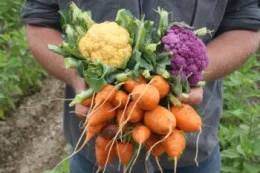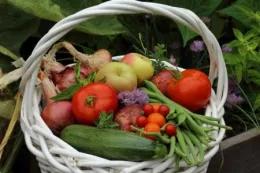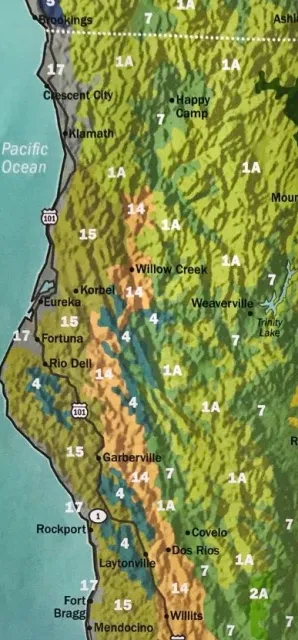Edible Gardens

Growing vegetables in your home or garden is good for you, your neighborhood, and for helping to reduce your global footprint on this earth.
Growing vegetables at home can be done in a single pot on your patio or on a larger scale depending upon the space and time you have available.
Good planning and preparation will reduce the workload in your garden. For example, if you install a drip system that can accommodate all of your beds, you will never have to drag an irrigation hose around. If you apply a heavy layer of course mulch between the beds, your weeding will be minimal. If you build raised beds, your garden will be more organized and less likely to degrade to weeds.
Virtual Classes and Presentations
Vegetable Gardening General Information

- The California Garden Web
The vegetable section is a great resource to find most of your answers on how to grow your own vegetable garden. - Vegetable Gardening 101 (ENH 96)
- Garden Basics (ANR Publication 8059) Planning, planting, tending to a home vegetable garden.
- Understanding a Seed Packet (GN 128)
- How to Start Seeds (California Garden Web)
- Vegetable Seed Saving (ANR Stanislaus County)
- Soil Temperature Conditions for Vegetable Seed Germination (GN 154)
- Vegetable Planting Guide from the Master Gardener Handbook provides estimated dates for planting, harvesting, and storage.
- Vegetable Container Planting Tips (GN 140)
- Growing Edible Flowers in Your Garden (GN 155) Edible flowers can bring lively flavors, colors, and textures to salads, soups, casseroles, and other dishes.
- Straw Bale Gardening (GN 160)
- Using Cereal Straw Bales for Home Gardening Washington State Publication
Planting Zones
Knowing your planting zone is critical. In the counties of Humboldt and Del Norte according to Western Sunset Garden Book there are 6. Both counties' Maritime zones are 17. Humboldt's Coastal zones are 14 and 15 depending on your location. Other zones in various areas of Humboldt are 4, 7 and 1a. Del Norte's various areas include 7 and 1a. Look at Sunset Zone Map to determine your Zone.

Planting Calendar by Zone
Cool season vegetables grow best and produce the best quality crops when average temperatures are 55-75o F. They usually tolerate slight frost when mature. Some crops can be grown year round in parts of Humboldt and Del Norte Counties.
Warm season vegetables require long, hot days and warm soil to mature. They grow best and produce the best quality crops when average temperatures are 65-95°F. They are intolerant of prolong freezing temperatures. Depending on your zone and your own microclimate Tomatoes and peppers are difficult to grow except in a greenhouse environment.
Planting Calendars—Eddie Tanner, author The Humboldt Kitchen Gardener
- Winter Gardening in Coastal & Low Elevation Humboldt
- When to Plant What in Inland Humboldt
- When to Plant What on the Humboldt Coast
California Weather Data App
Current daily and hourly data from stations throughout California, plus long-term data for climate stations. PestCast research networks provide hourly and daily values from selected locations.
Produce Safety
- Food Safety in Your Home Vegetable Garden UCANR PUB8366
- Safe Handling of Fruits and Vegetables UCANR PUB8121
- Key Points of Control and Management for Microbial Food Safety, Edible Landscape Plants and Home Garden Produce UCANR PUB8101
- Storing Vegetables and Fruits at Home Washington State University Extension EB326E
- Storing Fresh Fruits and Vegetables for Better Taste UC Davis Post Harvest PUB21590
- Harvesting and Storing Fresh Garden Vegetables University of Idaho Extension BUL617
- Freezing Fruits and Vegetables Pacific Northwest Extension PNW214
Cultural Practices & Pest Management
- IPM Vegetable and melon section. Information on best cultural practices, as well as identifying and managing pest problems.
- Attracting Beneficial Insects (GN 129)
- Attracting Native Pollinators (GN 156) Birds, bats, bees, butterflies, beetles, and other small mammals that pollinate plants are responsible for bringing us one out of every three bites of food. They also sustain our ecosystems and produce our natural resources by helping plants reproduce. Unfortunately, they are in trouble. Some species have seen a 90% decline in their populations over the last decade. But you can help. There are several ways to enhance your garden to make it more pollinator-friendly.
- Beneficial Predators UC IPM Quick Tip
- Soil Solarization UCANR Publication 21377. A nonpesticidal method for controlling diseases, nematodes, and weeds.
Publications with detailed information on growing these edibles
- Artichokes (UCD Veg Research) (ANR 7221)
- Asparagus (UCD Veg Research) (ANR 7234)
- Beans (UCD Veg Research)
- Broccoli (UCD Veg Research) (ANR 7211)
- Brussels Sprouts (MG Sonoma)
- Cabbage (UCD Veg Research) (ANR 7208)
- Cantaloupe (UCD Veg Research) (ANR 7218)
- Carrots (UCD Veg Research) (ANR 7226)
- Cauliflower (UCD Veg Research) (ANR 7219)
- Corn (UCD Veg Research) (ANR 7223)
- Cucumbers (UCD Veg Research) (ANR 8050)
- Garlic (UCD Veg Research) (MG Sonoma)
- Eggplant (UCD Veg Research) (ANR 7235)
- Lettuce (UCD Veg Research) (ANR 7216)
- Okra (UCD Veg Research) (ANR 7210)
- Onions (UCD Veg Research) (ANR 7242)
- Peas (UCD Veg Research) (ANR 7233)
- Peppers (UCD Veg Research) (Chili ANR 54052)
- Potatoes (UCD Veg Research)
- Pumpkins (UCD Veg Research) (ANR 7222)
- Rhubarb (UCD Veg Research) (ANR 8020)
- Spinach (UCD Veg Research) (ANR 7212)
- Squash Summer (UCD Veg Research) (ANR 7245)
- Sweet Potato (UCD Veg Research) (ANR 7237)
- Tomatoes (ANR 8159)
- Watermelon (UCD Veg Research) (ANR 7213)
